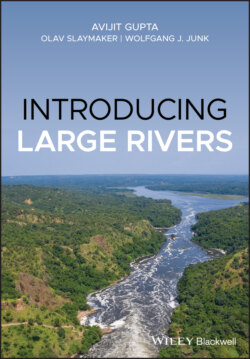Читать книгу Introducing Large Rivers - Avijit Gupta - Страница 17
2.4 The Subsurface Alluvial Fill of Large Rivers
ОглавлениеThe rock surface underlying the alluvial valley-fill of a large river generally is not smooth but marked by irregularities such as ribs, furrows, scour holes, etc. Schumm, for example, discussed the variable thickness of the Mississippi Valley alluvium at East St. Louis, Missouri as reported in the literature. The thickness of the alluvium reaches approximately 35–50 m in places (Schumm 1977). The depth of the alluvium and its nature are exhibited in boreholes, but a complete mapping is very difficult. Detailed three-dimensional studies have been carried out on several rivers (Fielding 2007). Construction of dams over large rivers also exposes surface morphology. The section at Hoover Dam on the Colorado River disclosed an inner channel flanked by bedrock terraces. About 200 km of the channel of the Changjiang were mapped between November 1978 and May 1979 near the site chosen later for the construction of the Three Gorges Dam. More than 90 troughs were found at the bottom of the river, cumulatively covering 45% of the total length of the river mapped. All the troughs were more than 40 m below the lowest river level (Yang et al. 2001). The cross-section of the channel of the Upper Mekong is trapezoidal, or has a deep inner channel bounded by rock benches, or a wide scabland-like section with rock ribs and piles rising from the bed (Figure 2.3). Scour pools and rock protrusions occur on the rock benches and the floor of the inner channel (Gupta 2007). The final bed of a big river thus is a composite result of structure and lithology at various scales.
The texture of the river-deposited fill over rock is not uniform. In general, the coarsest sediment is found at the base of the valley-fill and the finest towards the top (Schumm 1977). Sediment also tends to become finer in the downstream direction. However, sedimentation is also likely to indicate: (i) interrupted deposition; (ii) variations along the main channel due to differential contribution by tributaries; and (iii) variations from a general fining-upward sequence probably caused by climate change and tectonics. However, where the available sediment is of similar texture, the fill tends to be texturally rather uniform.
Valleys can be filled longitudinally in three ways. First, basin climate change or uplift of the source area may result in progressive aggradation of relatively coarse material deposited along the valley, downfilling the channel. Secondly, sediment from tributaries joining the trunk stream may vertically fill the valley relatively uniformly over a river reach. Thirdly, a rise in base level may reduce the gradient over the lower parts of the valley, initiating progressive backfilling (Schumm 1977).
Figure 2.3 Diagrammatic sketches of cross-sections of the Mekong River in rock, Lao PDR.
Source: Gupta 2004.
Tandon and Sinha (2007) summarised sedimentation in the Ganga River. Rising from the Himalaya Mountains, the river descends to the plains and flows parallel to the mountains for a considerable part of its course. It then erodes through the igneous Rajmahal Hills; turns south to build part of a major delta; and finally flows into the Bay of Bengal. The upper 20 km of the river downstream below the mountain front carries numerous gravel bars, the riverine alluvium consisting mainly of several metres of gravel. Coarse sand, corresponding to a braided channel belt, replaces gravels downstream (Shukla et al. 2001). This is followed downstream by the meandering and braided middle section of Ganga that deposits mostly fine to very fine sands on medium to coarse sands of older deposits. The fine sands are separated by units of floodplain clay, several metres thick and pedogenically altered, characteristics of a mobile river. Considerable volume of sediment also arrives to the Ganga as fan-deposits of the major Himalayan tributaries such as the Gandak or Kosi. The deposits of these megafans range from the mountain front to the Ganga in zones, from gravelly sand to fine sand and mud. These megafans consist of gravel beds in the upper areas, but most of the fan is made of multistoried sand sheets interbedded with overbank muddy layers (Singh et al. 1993).
Interpretation of both tectonic structures and subsurface fill is required to determine the geological background of a large river and explain its surface configuration. Natural sedimentation in a large river such as the Ganga is controlled primarily by tectonics, climate and sea level. Both tectonics and climate control the nature of the sediment near the mountains, the effect of the climate dominates further downstream along with the sediment supplied by both tributary fans from the mountains and sediment from cratons, and the effect of the changing sea level influences the lower part of the valley.
